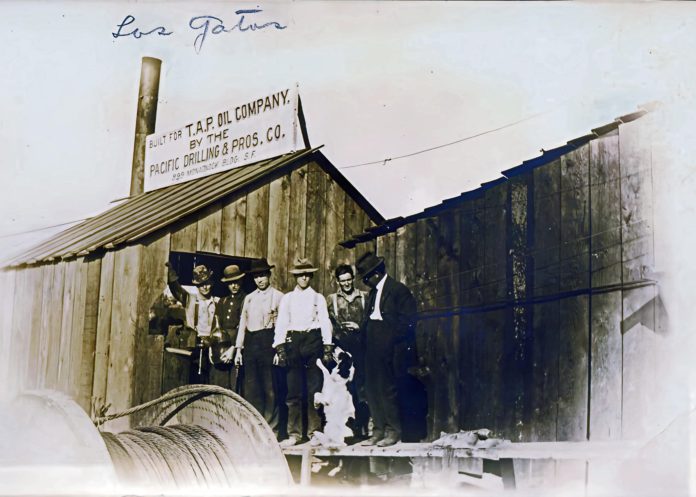
Have you ever wondered how the infamous U-shaped stretch of Highway 17 known as Big Moody Curve got its name? There isn’t much to say about early settler D. B. Moody, who owned the property. But what happened there is one of the most obscure and fascinating stories in early Los Gatos history.
In November 1861, lumberjacks working in a sawmill in the ravine nicknamed Moody Gulch noticed large pools of oil floating in the creek. Oil had been discovered in Pennsylvania just a few years beforehand, and fortune seekers who missed the Gold Rush went into a frenzy after a news story about the local find appeared in the San Jose Mercury-Herald.
In April 1865, the newly formed Santa Clara Petroleum Company began drilling in the gulch. However, it was the Shaw & Weldon Petroleum Company that actually struck oil five years later. Their wells weren’t profitable and both companies went bankrupt after only a few years. But that didn’t dampen “oil fever” in Los Gatos. A sprawling oil field was soon established in and around Moody Gulch. Prospectors and speculators filed mining claims there for oil and either drilled wells or sold their claims for a profit. Multiple wells were drilled in the oil field throughout the 1860s and ‘70s. In 1865, one well struck a large quantity of oil which was reported to have gushed up to 85 feet in the air. The most productive well produced more than 100 barrels a day, making it one of the more successful oil wells in the entire state of California at that time.
The last oil company in Moody Gulch closed in 1938
In 1878, the Pacific Coast Oil Company sank a highly profitable well and laid a two and a half mile pipeline to a new platform next to the South Pacific Coast Railroad tracks. Their oil was pumped into a large holding tank and was barreled for transportation by rail to a refinery on Alameda Point. A railway station named Oil City was established with the expectation that a boomtown would emerge on the site. It was renamed Oleoso (Spanish for “oily”) but never became more than a freight stop.
Multiple oil companies continued drilling in Moody Gulch and the surrounding area throughout the late 19th and early 20th centuries. According to a story in the Los Gatos Mail News on Dec. 16, 1920, the Trigonia Oil Company’s wells “are producing at the highest capacity” yielding up to 50 barrels a day with a net income of almost $120,000 per year ($1.9 million in today’s dollars.) Another story in the same newspaper boasted that “there is no doubt California will someday excel by far the famed Pennsylvania petroleum region… and Santa Clara County will beat the State”.
The last oil company in Moody Gulch closed in 1938. Although later attempts to extract oil failed to produce profitable quantities, it is estimated that nearly 4.5 million gallons of oil were extracted in the 77 years that companies operated in the gulch area.
Realignment and widening of Highway 17 involved filling in a large portion of Moody Gulch. Any wells that remained were capped, and all traces of the oil fields were buried forever under tons of earth bringing to an end this long forgotten period in Los Gatos history.
Alan Feinberg is a local historian and founder of the LOST Gatos Project www.lostgatos.com. His mission is to generate enthusiasm among Los Gatos residents for remembering and preserving our town’s unique character and historic treasures before they’re lost forever. For more Los Gatos history, download the free mobile app Discover LOST Gatos and take a self-guided walking tour through our historic downtown.









